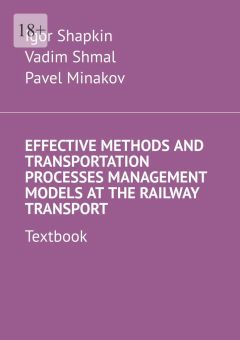Текст книги "Effective Methods and Transportation Processes Management Models at the Railway Transport. Textbook"

Автор книги: Igor Shapkin
Жанр: Прочая образовательная литература, Наука и Образование
Возрастные ограничения: +18
сообщить о неприемлемом содержимом
Текущая страница: 10 (всего у книги 11 страниц)
9 COST-EFFECTIVENESS OF DECISION-MAKING METHODS AND MODELS IN RAILWAY TRANSPORT
9.1 Logistic model of the transportation process corporate quality management
Logistic model of transportation process management, formed within the framework of a functional project for the transition to a new model of corporate quality management in production departments: transportation management and commercial work in the field of freight transportation.
The implementation of this project will be carried out on a project basis with a clear definition of targets and deadlines for their implementation, planning of the required resources and the effectiveness of project implementation.
Planning of work on the implementation of the project:
1. Reengineering of business processes and development of a plan for their implementation.
2. Appointment of owners, managers and executors of business processes, distribution of duties and responsibilities.
3. Familiarization and training of department personnel with the content of the project and tasks related to the deployment of business processes at the 2nd cascade level, the matrix of authority and distribution of responsibility.
4. Structuring and documenting the quality management system in the administrative management system, writing and approving specific action procedures for managers and employees of all structural units.
5. Involvement of personnel in quality improvement processes.
6. Implementation of the principle of «fact-based decision-making».
7. Organization of periodic internal audit.
8. Implementation of the principle of continuous improvement of the quality of the transportation process.
9. Creation of a coordinating council chaired by the supervising vice-president, determination of the necessary resources, organization of «fan» training of personnel based on computer technology, distance learning and knowledge testing.
Work on the implementation of the project is planned to be organized according to the following main stages:
The content of the first stage is to detail business processes and bring them to the level of functional operations in the divisions of departments and relevant services of railways. In some cases, it seems that it will be necessary to adjust individual processes based on existing technologies of the transportation process.
To improve the service of senders and consignees of goods on the basis of monitoring of intermediate indicators and improving the technology of transportation, it is planned to use the methodology of reengineering (redesign) of business processes.
The main task of reengineering is the rethinking and redesign of existing business processes to implement deeply justified changes in transportation technology, accompanied also by proactive coordination of supply and demand in the field of transportation, adaptation of services and tariffs to the dynamics and needs of the market.
Depending on the required level of need for optimization of business processes, the quality improvement strategy can be adopted in combination or with a combination of the following actions:
– individual improvements;
– adaptation of existing processes to the peculiarities of new conditions, new opportunities or a new level of development (state) of infrastructure;
– replacement of existing technological processes with new ones;
– automation of processes.
Based on the process analysis of the existing links of the transportation process, an assessment of possible directions of reform is carried out and it is determined which links need to be debugged or modified. At the same time, great importance is attached to closer information interaction of all entities involved in the business processes of transportation.
The work should be completed by the approval of the Passports of the processes of the quality management system, which indicate all suppliers of this process without exception, both internal and external, as well as all inputs of this process – material flows, information and documentary flows.
At the second stage, it is planned to revise the distribution of responsibilities in the departments and develop matrices for the distribution of powers and responsibilities, appoint owners, managers and executors of business processes.
A system of leadership is being established in the departments of the CD and CM, the relevant services and divisions of transportation. At the linear level, the personal quality leader is the head of the railway station. Responsibility for the implementation of transformations aimed at improving key indicators is distributed among the deputy heads of departments of the CD and CM, the relevant services and divisions of transportation.
At the third stage, department personnel are familiarized and trained with the content of the project and tasks related to the deployment of business processes at the 2nd cascade level, the matrix of authority and distribution of responsibility. Within the framework of the project, a study of management processes in the departments of the Central House and the Digital Brain was carried out.
It has been established that the main reason for the poor-quality execution of orders and decisions in the field of the transportation process is the insufficient qualification of the executors (30%) and the inconsistency of the instructions with the terms of reference of the employee (26%); only 50% of the meetings held directly contribute to the solution of the tasks; Only 75% of the completeness of information is covered, and the share of information collected manually from the railways exceeds 40%. These data indicate that there is room for improvement in the quality of management from internal resources related to the improvement of the administrative management system.
During the fourth stage, the quality management system in the administrative management system is structured and documented, specific action procedures are written and approved for managers and employees of all structural units.
Here the following main tasks should be solved:
– determination of requirements for the implementation of processes (conversion of input indicators of processes into output indicators);
– ensuring effective business process management;
– recording of actual data on the implementation of quality indicators of the transportation process;
– quality control of cargo and passenger transportation, as well as compliance with design levels of business processes;
– resolution and prevention of inconsistencies and deviations from the design levels of business processes in practice.
At the next, fifth stage, it is planned to implement a set of measures to involve personnel in quality improvement processes, to identify and appoint mid-level quality managers and quality masters. Activities are based on the results of a clear structuring and documentation of responsibilities, distribution of responsibilities and motivation of work.
The implementation of this quality principle involves the following steps:
– explanation of the goals, objectives and methods of implementation of the quality management system in the unit (with the passing of a test to determine the level of knowledge and the degree of involvement of the employee in quality management – in the rank of middle quality manager or quality master);
– Issuance of quality manuals for each level of transportation process management;
– issuance of technological documentation and work instructions for each workplace, establishing the procedure for performing work, monitoring and reporting;
– identification and arrangement of teams of functionally interconnected employees for the reengineering of business processes in order to implement quality benchmarks. If necessary, carrying out structural reforms within the total number of staff;
– determination of the list and forms of reporting documents for each level of management on the quality of work on benchmarks, as well as information systems for maintenance and monitoring;
– revision of the motivation system for high performance and creative activity of employees.
Motivational levers of personnel management should be applied, first of all, to solve the problem of impeccable implementation of the schedule of passenger and freight trains, as the main tool for ensuring the timely delivery of goods and passengers.
9.2 Methods and tools for making effective transportation management decisions on the railway network
The operational work of railways is a complex set of continuous interconnected technological and information processes that ensure traffic safety, meet the needs of passengers and customers in transportation, efficient use of infrastructure, rolling stock, labor and energy resources.
Operational work is the basis of the activities of the production unit of Russian Railways. The sales unit ensures the attraction of goods, planning of traffic volumes, revenues and expenses, and the application of tariff policy. The infrastructure unit provides for the current maintenance, repair and development of railway infrastructure facilities.
At present, in the context of the construction of vertically integrated directorates in the management structure of Russian Railways, fundamental changes in the conditions for managing a private car fleet, fluctuations in traffic volumes, increased polygons for locomotive circulation, etc., planning, coordination and control of horizontal technological relations operations for the promotion of trains, regulation of car fleets, locomotives and crews are weakening.
In the management structure of Russian Railways, there is an increase in the number of divisions of the Central Office of Directorates and Departments, while at the line level there is an annual reduction in personnel directly related to the performance of the functions of technological processes and the formation of primary information, as a result of which the downtime of trains and wagons increases, operating costs increase, and the quality of primary information decreases.
The boundaries of existing and newly created subdivisions (for example, Traction Resource Control Centers) are set by the administrative boundaries of railways, points of change of the type of electric traction current, while the structure and geography of train traffic has a completely different structure.
The necessary conditions for the effective solution of the problems of railway transport, its systematic qualitative development, flexible adaptation to external economic and political conditions are:
– coordinating the implementation of the functions of individual directorates of the vertically integrated structure in solving corporate strategic, tactical and operational tasks of Russian Railways;
– strengthening of horizontal technological connections of the end-to-end polygon technology of train traffic;
– a unified technical policy in terms of infrastructure development, the use of traction resources, advanced systems and control methods at the network landfills;
– adaptation of the regulatory and technological framework to modern conditions;
– development of an effective management structure with a reasonable ratio of personnel: managers and line workers;
– development and application of information, management and analytical management models in the technological and economic aspect, taking into account not only internal corporate processes, but also external economic conditions;
– automation of the formation of primary information about the state of control objects,
– development and application of methods for assessing the work of departments based on comprehensive performance indicators,
– development and implementation of fundamentally new technical, technological and information solutions that provide end-to-end control technology,
– comprehensive training of specialists and managers, conducting regular trainings to work in modern conditions,
– development and implementation of technical and information means of data exchange of control centers and mobile objects.
Let’s consider the methods of achieving the above conditions and measures for the production unit of Russian Railways.
The basis of the technology of the transportation process is the train schedule, the formation plan, the rules of technical operation, the instructions for the movement of trains, the instructions for signaling, the technological processes of work and the regulations for the interaction of units. Operational work is determined by the shift-daily and current plan of train and freight work.
These documents regulate the technological side of the management process, while the economic component remains in the background, which is unacceptable in modern conditions.
Currently, managers at all levels of the transportation management vertical are primarily guided by technological, quantitative and qualitative performance indicators. A labor motivation system is set up for their implementation. A preliminary assessment of possible economic consequences (additional costs or savings) in the planning of control actions and a financial assessment of the decisions made in the operational mode is not carried out. Meanwhile, a preliminary analysis of options for solving operational problems from an economic point of view can greatly influence the final decision.
Managers and dispatching personnel solve many interdependent logical problems, form tasks for performance indicators, restrictions, monitor the implementation of decisions made, develop adjustments to previously established plans in case of critical deviations and failures in the implementation of technological processes. Tasks, as a rule, are combinatorial and probabilistic in nature. The manager operates with aggregated and calculated quantitative indicators, the dispatching apparatus operates with specific control objects (trains, locomotives, wagons, stations) to fulfill the assigned tasks in terms of quantitative and qualitative indicators.
The activity takes place in a rapidly changing situation, a constant shortage of time, a multitude of factors influencing decision-making, a lack of reliable and timely information (paradoxically, but at present there is an excess of input flow of unsystematized information, and it takes considerable time to extract from this flow the really necessary data for decision-making by a particular leader!).
For a modern leader, it is important to have a tool to calculate the consequences of their decisions, both technological and economic, to identify good (acceptable) solutions in advance, before the onset of critical negative phenomena, relying on previously accumulated experience and hidden dependencies and influencing factors identified in an automated mode according to specified criteria. But, in addition to the availability of a tool, an important condition is knowledge of the methodology for accepting effective conditions and the ability to apply it in practice.
Let us consider in more detail the basic principles of the methodology for making effective decisions, taking into account technological and economic aspects.
Decision-making is a process consisting of specific sequential stages. The result of the solution should be some kind of action or command to fix the problem.
The main stages of decision-making include classifying the problem, determining the way to solve the problem and checking the validity and effectiveness of the solution for compliance with the real state of affairs.
In the process of implementing the solution, there should be regular monitoring of whether the desired result is achieved, and in case of deviation, you should return to adjust the solution.
The tasks of the operational work of Russian Railways can be divided into management objects: the interstate level, the network level of Russian Railways, the polygon level, the road sublevel, and the line level. The higher the level, the greater the influence on decision-making has economic criteria. The quality of the implementation of solutions primarily depends on the enterprises of the linear and polygon levels.
The higher the level of management, the greater the share of strategic and tactical tasks, long-term and medium-term for the period of action. At the linear level, operational short-term tasks are solved and the stages of strategic, tactical (preventive) tasks set at the upper levels of management are directly implemented.
Operational models help to make decisions on specific transportation management tasks at the landfill and line level, offering options for the dispatcher to choose from. At the same time, economic parameters should not be taken into account explicitly (it is difficult for the dispatcher to assess the weight of the consequences in an operational situation), but in the form of parameters that he can really influence (district speed, number of stops, train downtime at stations, etc.). The value rating of each option for solving an operational task directly depends on these parameters, but they are different for each operational task. The problem is also that in the operational environment, there is often a choice between solutions in which the option is preferred for technological reasons (for example, «To let trains pass by any means, including by throwing or stopping other trains!») rather than on economic criteria.
At the network level, conditions, technology for implementation and quality control indicators for strategic and tactical tasks are formed across the entire Russian Railways network in cooperation with the railway networks of neighboring countries and other modes of transport. It also provides control, analysis, coordination of the work of landfills, the solution of adjustment problems in the network.
At the polygon level, tactical, preventive and operational tasks are formed on the scale of the allocated polygon of the Russian Railways network (5—6 landfills), the entire regulatory and technological base for the landfill, shift, daily, current planning of train work, and setting priorities for the passage of trains are developed.
The existing inter-road joints between the roads that are part of the same polygon cease to be joints as such, artificially restricting the possibility of passing train traffic at the present time. For example, such stations as: Chertkovo, Morozovskaya, Kotelnikovo, Oleynikovo, Duplyatka, Blagodatka, etc., within the boundaries of the Southern polygon, become ordinary stations – the boundaries of neighboring control areas.
At the joints there should be a «seamless» laying of threads of the traffic schedule so that there are no inconsistencies in the time parameters of the thread with the same number on the side of each of the neighboring railways. The development of the schedule after the installation of control points for the transition of transit freight and passenger trains at interstate joints should be carried out at the field level of management. The existing docking stations will remain control stations in order to monitor the quality of train passage and the responsibility of the dispatching apparatus of the neighboring traffic control directorates included in the landfill.
The instrumental basis of the integrated polygon technology for passing train flows is automated systems for planning, forecasting, modeling, monitoring and analyzing the implementation of control decisions. The presentation of the interface of the tasks of these systems and the results of their work should be organized within the framework of the functionality of automated workplaces (AWP) of specific employees (managers, dispatchers, engineers) in accordance with the technological map of their work. On the one hand, AWP reflects the results of the work of numerous systems in a single interface, on the other hand, it is a source of one-time formation of unique information, which is the initial data of other systems or guidelines (tasks, standards) for other employees.
Let’s consider modern information systems that allow you to make effective decisions.
At present, there is a need to switch to a single enterprise-level business intelligence platform for providing information to Russian Railways employees in order to achieve the tasks set.
A distinctive feature of BI products in the operational environment is that they give a complete picture of the situation in dynamics (including structured indicators for landfills, trains, wagons, locomotives, crews in various sections and samples).
If managers are in control of the situation, they can plan their actions within their management range, use the predictive, actual regulatory information of different systems and tasks in a single interface of their personal workplace, both stationary and mobile.
An important stimulus for the use of BI solutions is the need to improve the quality of decisions made, their accuracy and timeliness, especially in failure situations. At present, the directorates and departments of Russian Railways are experiencing significant difficulties associated with the use of disparate information systems that do not allow for the coordinated work of various functional units.
One of the options for a unified business intelligence platform that solves the problem of effective use of information for analysis and decision-making in Russian Railways divisions is the Oracle Business Intelligence Suite.
Oracle Business Intelligence Suite Enterprise Edition (Oracle BI) is an integrated, high-performance tool environment that supports a wide range of modern technologies and methods of business analysis and provides access to heterogeneous information sources. The software package operates on the basis of a single analytical and computing infrastructure, a unified metadata management model, a unified security system and user privilege management, as well as common administration tools. This package provides high performance and scalability, providing extensive query optimization capabilities based on the type of data source used, advanced computing tools.
The data required by the user is provided in a «clean» WEB-environment on information panels with a wide arsenal of graphical and tabular presentation tools, the ability to «drill» data, event notification tools according to specified criteria.
The personalized interface also allows the user to perform ad hoc queries on the topics available to him to quickly get the desired view of the data (tabular, in the form of a graph, Pareto chart, etc.) without the help of programmers. Oracle BI software tools allow you to create an electronic journal of output forms and use it both online and offline, if necessary, updating the data in the desired set of information representations. Also, the user has the opportunity to use the system both at his workplace in the office, and on a laptop, IPhone and iPad devices outside the office.
Calls to existing and newly developed forms and applications (including simulation models) can be embedded in the dashboards of the Oracle BI workstation interface.
To support decision-making, managers and dispatchers of Russian Railways can be recommended to use the Oracle Real-Time Decisions (Oracle RTD) system, which provides a management infrastructure for generating recommendations when interacting with the user. Oracle RTD operates in multi-channel real-time.
Oracle RTD applies a predictive model and business rules to provide optimal recommendations in terms of goals for specific operational tasks in its management plane that may contradict each other. The model results are embedded in the user interface built on Oracle BI.
The process of issuing recommendations in RTD is inextricably linked to the feedback process. This approach provides much higher efficiency than rule-based systems, as well as traditional forecasting models.
Oracle Real-Time Decisions allows:
– generate intelligent, relevant recommendations in real time on the range of tasks to be solved;
– take into account all information from solutions to similar problems in the past to find solutions to current problems using forecasting algorithms and rules set by experts;
– create self-tuning (with a closed loop of self-tuning) business processes by integrating Business Intelligence (BI) into the interaction process.
To create models that implement the tasks of planning and forecasting flows, it is advisable to use the Oracle Strategic Network Optimization software product, which allows you to describe the supply chain model using graphical tools, the main components of which are the sources of loaded and empty car flows, transport networks, stations, sections. In general, a supply chain is a set of nodes connected by arcs.
Each node or arc has user-defined properties. At the same time, several nodes can be combined into blocks (for example, control areas, landfills, railways, locomotive circulation areas). For blocks, you can specify their geographical reference and view the resulting supply chain diagram on electronic maps.
The program provides the ability to search for an optimized (but not optimal) solution under conditions of nonlinear constraints. To do this, heuristics are set in the system that allow describing such processes as: the formation of trains at technical stations, operating costs for passing car flows, time parameters of movement and downtime, loading, unloading, etc. To build a specific model, the base model is calculated and calibrated, scenarios are analyzed, and reports are created for the user.
There are other software products that allow you to optimize decision-making in the field of operational management in railway transport.
In conclusion, it is worth noting that effective decision-making is a kind of art, but modern computing systems and decision-making methodology can help managers master it. It is possible to download a manager with a large amount of all kinds of information from different systems that currently exist, but he will not be able to find the right solution in a limited time. If the system helps to look for solutions, frees from the routine work of formalizing management actions, monitoring and analyzing their implementation, and the manager is trained in decision-making methodology, including taking into account economic factors, then he will make the right decision. There is no need to create new divisions, it is necessary to teach managers and dispatchers to make the right decisions and equip them with modern tools. This is the task of the research and educational institutes of the industry, and the task of the Russian Railways Group is to move to a new qualitative level of efficiency and quality of production management.
- ВКонтакте
- РћРТвЂВВВВВВВВнокласснРСвЂВВВВВВВВРєРСвЂВВВВВВВВ
- Telegram
- Viber
Правообладателям!
Это произведение, предположительно, находится в статусе 'public domain'. Если это не так и размещение материала нарушает чьи-либо права, то сообщите нам об этом.








































